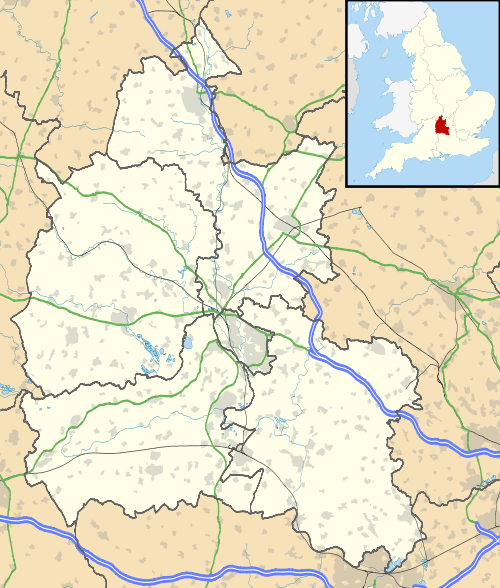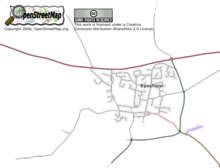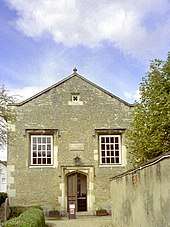Eynsham
Eynsham /ˈɛnʃəm/ is an English village and civil parish about 5 miles (8 km) north-west of Oxford and east of Witney in Oxfordshire. The 2011 Census recorded the parish population as 4,648.[1]
| Eynsham | |
|---|---|
St Leonard's parish church | |
 Eynsham Location within Oxfordshire | |
| Population | 4,648 (parish, including Barnard Gate) (2011 Census) |
| OS grid reference | SP4309 |
| Civil parish |
|
| District | |
| Shire county | |
| Region | |
| Country | England |
| Sovereign state | United Kingdom |
| Post town | Witney |
| Postcode district | OX29 |
| Dialling code | 01865 |
| Police | Thames Valley |
| Fire | Oxfordshire |
| Ambulance | South Central |
| UK Parliament | |
| Website | Eynsham Online! |
History
Eynsham grew up near the historically important ford of Swinford on the River Thames flood plain. Excavations have shown that the site was used in the Bronze Age for a rectilinear enclosure on the edge of the gravel terrace.
The Anglo-Saxon Chronicle records Eynsham as Egonesham and describes it as one of four towns that the Saxons captured from the Britons in AD 571. Evidence has been found of 6th and 7th-century Saxon buildings[2] at New Wintles Farm,[3] about three-quarters of a mile (1 km) from the present parish church. There is some evidence that Eynsham had an early minster, probably founded in the 7th or 8th centuries.[2] The name is recorded in AD 864 (in the dative) as Egenes homme, i. e. "Ægen's enclosure or river-meadow".
In 1005 Aethelmar, kinsman of Aethelred II founded a Benedictine abbey on the site of the earlier minster. The first abbot was Ælfric of Eynsham, a prolific writer in Old English.[4] The Domesday Book of 1086 includes a paragraph about the settlement, then known as Eglesham.[5]
By 1302 Eynsham had a wharf handling cargo that included hay, straw, malt, grain and timber, beside the later Talbot Inn on Wharf Stream, a tributary of the Thames.
By the medieval period Eynsham Abbey was one of the largest in the area, but it was dissolved at the Reformation in 1538 and only a few remains can still be seen. After the dissolution, the abbey estates were given to Sir George Darcy.[6]
By 1790 a newly completed Oxford Canal was trading with Eynsham Wharf, mainly to sell coal from the Midlands.[7] From 1792 the Oxford Canal employed a wharfinger at Eynsham[8] and in 1800 it bought the lease of the wharf.[9] The Oxford Canal consolidated its position at Eynsham by buying the Talbot Inn in 1845 and the freehold of Eynsham Wharf in 1849,[10] perhaps in response to the Railway mania that was beginning to take traffic from canals and navigations.
Eynsham Lock is on the Thames just above the confluence with Wharf Stream. This was the last flash lock on the Thames, not rebuilt as a pound lock until 1928.

The village suffered a number of fires in its history.[11] Two of the most serious were one on the morning of Whit Monday 1629[11] that destroyed 12 houses[12] and another in 1681 that destroyed 20 houses.[11] By the early 19th century the parish had its own fire engine – from then until 1949 the ground floor of the early 18th-century Bartholomew Room served as the parish fire station.[13]
The Bartholomew Room was built in 1703 out of an endowment from John Liam Bartholomew in 1701 to found a charity school for the parish.[13] Its lower storey was arcaded, presumably to serve as a market building.[13] The arcades were walled up in the latter part of the 19th century.[13] While some of the ground floor continued to serve as the fire station, another was turned into a village gaol.[13] From 1928, the local Roman Catholic congregation used the upper room for its services.[14] In 1983 the parish council bought and restored the building.[13]
Roads
By the mid-18th century, Swinford had a ferry, but the main road was in poor condition. Heavier road traffic between Oxford and Witney preferred to pass further north via Bladon, where the better-maintained Oxford–Woodstock and Witney–Woodstock roads met. When the latter became a turnpike in 1751, the road via Eynsham and Swinford ferry was included as a branch.[13] In 1769 the Earl of Abingdon opened Swinford Toll Bridge to replace the ferry. The Witney–Woodstock road ceased to be a turnpike in 1869, but the Witney–Oxford road remained one until 1877.[13]
Eynsham was a major coaching stop on the London–Fishguard road. Since 1922 this has been classified as the A40. In 1936 a bypass for the main road was built north of the village, and the road over Swinford bridge reclassified as the B4044.
Rail
The Witney Railway between Witney and Yarnton opened through Eynsham parish in 1861. The station was on the south side of the village. The Great Western Railway took over the line in 1890 and enlarged Eynsham station in 1944. British Railways closed the line to passenger trains in 1962. In 1970 the line closed also to goods traffic and the track was dismantled. The station has since been demolished and a business park built on the site.
In February 2015 the Witney Oxford Transport Group proposed reopening the station as an alternative to improvements to the A40 road proposed by Oxfordshire County Council. The case centred on the severe traffic congestion on the roads to and from Oxford.[15]
Churches
Church of England
The Church of England parish church of Saint Leonard was built the 13th century. In the 15th century the nave was rebuilt, a clerestory and north aisle were added and the west tower was built.[17] There are Mass dials on the south wall. The building has been restored three times: by William Wilkinson in 1856, Harry Drinkwater in 1892[17] and over a period of eight years in the 1980s.
The west tower has a ring of six bells. James Keene of Woodstock cast the third bell in 1653. Richard Keene cast the fifth bell in 1673. John Taylor & Co of Loughborough cast or recast the treble, second, fourth and tenor bells in 1895. The church has also a Sanctus bell that Mears and Stainbank of the Whitechapel Bell Foundry cast in 1924.[18]
St Leonard's is a Grade II* listed building.[19]

Roman Catholic
In 1895 Herbert May founded a Roman Catholic mission at his home, Newland Lodge.[14] The lodge burnt down in 1897, after which Mass was said at the Railway Inn until May had a new house built for him.[14] The mission closed when May moved to Oxford.[14] In 1928 the Roman Catholic parish of Witney leased the upper storey of the Bartholomew Room, making it St. Peter's Chapel.[14] Building of a new Roman Catholic church was begun in the 1930s but was delayed by the Second World War and not completed until 1967.[14]
Amenities
Local industries include gravel extraction and the large superconducting magnet factory, Siemens Magnet Technology Ltd. There is also a business park on the village outskirts.
Eynsham Primary School[22] is a community primary school. Bartholomew School[23] in Eynsham is the county secondary school for the village and surrounding area. As a specialist technology college, it draws its pupils mainly from the primary schools of Eynsham, Standlake, Stanton Harcourt, Freeland, Cassington and Hanborough.[24]
Eynsham Football Club plays in Witney and District Football League Division One.[25] Eynsham Sports and Social Club plays in Witney and District Football League Division Three and its reserve team plays in Division Four.[26] Eynsham Cricket Club[27] plays in Oxfordshire Cricket Association League Division Three.[28]
Eynsham has a Women's Institute[29] and a Morris dancing side.[30]
Notable residents
In order of birth:
- Dida of Eynsham (late 7th century) was a Mercian noble.
- Ælfric of Eynsham (c. 955 – c. 1010) served as a monk, abbot and religious writer.
- Adam of Eynsham (early 13th century) was monk, abbot and writer.
- Anthony Kitchin (1471–1563) became Abbot of Eynsham, then Bishop of Llandaff.
- Thomas Jordan (c. 1612–1685), child actor and poet, may have been born in Eynsham, where his family had land.
- E. K. Chambers (1866–1954), Shakespeare scholar and local historian, retired to Eynsham and died there.
- Eric Gordon (1905–1992), Bishop of Sodor and Man, retired to Eynsham and died there.
- Mollie Harris (1913–1995), actress and author, lived in Eynsham and wrote a book about it (From Acre End, 1982).
- Tommy Vance (1940–2005) was a BBC Radio 1 and Virgin Radio disc jockey born in Eynsham.
- Anthony J. Batten (born 1940), Canadian visual artist, was born at Eynsham Hall.
See also
- Crossings of the River Thames
- Locks on the River Thames
- Tilgarsley
References
- UK Census (2011). "Local Area Report – Eynsham Parish (1170217937)". Nomis. Office for National Statistics. Retrieved 2 August 2018.
- Blair 1994, p. 63.
- Rowley 1978, p. 97.
-

- Eynsham, Some interesting and notable dates in the history of our village
- Eynsham, Some interesting and notable dates in the history of our village
- Compton 1976, p. 58.
- Compton 1976, p. 59.
- Compton 1976, p. 60.
- Compton 1976, p. 117.
- Crossley & Elrington 1999, pp. 110–115.
- Emery 1974, p. 118.
- Crossley & Elrington 1999, pp. 98–110.
- Crossley & Elrington 1999, pp. 152–153.
- Elvery, Martin (5 February 2015). "Campaigners want new railway station at Yarnton to ease A40 congestion in West Oxfordshire". Witney Gazette. Newsquest. Retrieved 12 February 2015.
- Company site. Retrieved 9 July 2019.
- Sherwood & Pevsner 1974, p. 600.
- Davies, Peter (5 November 2016). "Eynsham S Leonard". Dove's Guide for Church Bell Ringers. Central Council of Church Bell Ringers. Retrieved 2 August 2018.
- Historic England. "Church of St Leonard (Grade II*) (1048964)". National Heritage List for England. Retrieved 2 August 2018.
- Crossley & Elrington 1990, pp. 153–154.
- Historic England. "Eynsham Baptist Church (Grade II) (1048984)". National Heritage List for England. Retrieved 2 August 2018.
- Eynsham Primary School Archived 4 September 2009 at the Wayback Machine
- Bartholomew School
- Bartholomew School
- Witney and District Football League
- Witney and District Football League
- Eynsham Cricket Club
- Oxfordshire Cricket Association
- "Oxfordshire Federation of Women's Institutes". Archived from the original on 7 September 2003. Retrieved 8 July 2009.
- Eynsham Morris
Bibliography
- Aston, Michael; Bond, James (1976). The Landscape of Towns. Archaeology in the Field Series. London: J.M. Dent & Sons Ltd. pp. 81–83, 97–98. ISBN 0-460-04194-0.CS1 maint: ref=harv (link)
- Blair, John (1994). Anglo Saxon Oxfordshire. Stroud: Alan Sutton Publishing. p. 63. ISBN 0-7509-0147-0.CS1 maint: ref=harv (link)
- Chambers, Sir Edmund (1936). Eynsham Under the Monks. XVIII. Oxfordshire Record Society.CS1 maint: ref=harv (link)
- Compton, Hugh J (1976). The Oxford Canal. Newton Abbot: David & Charles. pp. 58–59. ISBN 0-7153-7238-6.CS1 maint: ref=harv (link)
- Crossley, Alan; Elrington, C.R. (eds.); Baggs, A.P.; Blair, W.J.; Chance, Eleanor; Colvin, Christina; Cooper, Janet; Day, CJ; Selwyn, Nesta; Townley, Simon C. (1990). A History of the County of Oxford. Victoria County History. 12: Wootton Hundred (South) including Woodstock. London: Oxford University Press for the Institute of Historical Research. pp. 98–158. ISBN 978-0-19722-774-9.CS1 maint: extra text: authors list (link) CS1 maint: ref=harv (link)
- Emery, Frank (1974). The Oxfordshire Landscape. The Making of the English Landscape. London: Hodder & Stoughton. pp. 40, 42, 53, 55, 56, 111, 118, 148, 150, 163, 164, 167, 191, 192, 209. ISBN 0-340-04301-6.CS1 maint: ref=harv (link)
- Keevil, G.D. (1995). In Harvey's House and God's House. Thames Valley Landscape Series. 6. Oxford: Oxford University School of Archaeology. ISBN 0-904220-10-9.CS1 maint: ref=harv (link)
- Page, WH, ed. (1907). A History of the County of Oxford. Victoria County History. 2: Ecclesiastical History, etc. Westminster: Archibald Constable & Co. p. 156.CS1 maint: ref=harv (link)
- Sherwood, Jennifer; Pevsner, Nikolaus (1974). Oxfordshire. The Buildings of England. Harmondsworth: Penguin Books. pp. 600–603. ISBN 0-14-071045-0.CS1 maint: ref=harv (link)
External links
| Wikimedia Commons has media related to Eynsham. |
